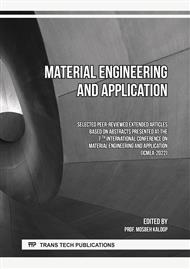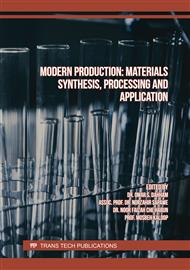[1]
E.K. Sales, Durian marker kit for durian (Durio zibethinus Murr.) identity, International Journal of Biological, Biomolecular, Agricultural, Food and Biotechnological Engineering. 9(5) (2015) 518-528.
Google Scholar
[2]
M.S. Añabesa, D.V. Oria, E.B. Esguerra, M.A. Sarcos, Postharvest behavior & storage life of 3 durian cultivars with varying maturity, waxing & temperature, Philippine Journal of Crop Science. 31(1) (2006) 29-46.
Google Scholar
[3]
O.C. Pascua, M.S. Cantila, Maturity indices of durian (Durio zibethinus Murray), Philippine Journal of Crop Science. 17(3) (1992) 119–124.
Google Scholar
[4]
CountrySTAT Philippines, Philippine Statistics Authority, https://openstat.psa.gov.ph/ (2017).
Google Scholar
[5]
R.G. Abad, K.J.T. Cruz, Incidence of Phytophthora fruit rot on four durian cultivars in Davao City, Philippines, Acta Horticulturae. 1006 (2013) 35-39.
DOI: 10.17660/actahortic.2013.1006.2
Google Scholar
[6]
L. Mellejor, Davao City remains top producer of durian fruit, Philippine News Agency. (2018).
Google Scholar
[7]
M.C. Lee, S.C. Koay, M.Y. Chan, M.M. Pang, P.M. Chou, K.Y. Tsai, Preparation and characterization of durian husk fiber filled polylactic acid biocomposites, MATEC Web of Conferences. 152 (2018) 02007.
DOI: 10.1051/matecconf/201815202007
Google Scholar
[8]
S.C. Koay, V. Subramanian, M.Y. Chan, M.M. Pang, K.Y. Tsai, K.H. Cheah, Preparation and characterization of wood plastic composite made up of durian husk fiber and recycled polystyrene foam, MATEC Web of Conferences. 152 (2018) 02019.
DOI: 10.1051/matecconf/201815202019
Google Scholar
[9]
C. Zhao, X. Cui, Y. Liu, R. Zhang, Y. He, W. Wang, C. Chen, G. Liu, Maximization of the methane production from durian shell during anaerobic digestion, Bioresource Technology. 238 (2017) 433–438.
DOI: 10.1016/j.biortech.2017.03.184
Google Scholar
[10]
M.R. Manshor, H. Anuar, M.N.N. Aimi, M.I.A. Fitrie, W.B.W. Nazri, S.M. Sapuan, Y.A. El-Shekeil, M.U. Wahit, Mechanical, thermal and morphological properties of durian skin fibre reinforced PLA biocomposites, Materials & Design. 59(6) (2014) 279–286.
DOI: 10.1016/j.matdes.2014.02.062
Google Scholar
[11]
PAEDA, 49th Biennial Convention, Philippine Agricultural Economics and Development Association (2013).
Google Scholar
[12]
R. Lubis, S. W. Saragih, B. Wirjosentono, E. Eddyanto, Characterization of durian rinds fiber (Durio zubinthinus, murr) from North Sumatera, AIP Conference Proceedings. 2049(1) (2018) 020069.
DOI: 10.1063/1.5082474
Google Scholar
[13]
Philippine Statistics Authority, Crop Statistics of the Philippines 2013-2017 (2018).
Google Scholar
[14]
C.R. Rajeesh, K.K. Saju, Effect of chemical treatment on fire-retardant properties of medium density coir fiber boards, Wood and Fiber Science. 49(3) (2017) 1-6.
DOI: 10.22382/wfs-2018-012
Google Scholar
[15]
W. Wiyaratn, A. Watanapa, A study on mechanical properties of fiberboard made of durian rind through latex with phenolic resin as binding agent, World Academy of Science, Engineering and Technology, Open Science Index 65, International Journal of Materials and Metallurgical Engineering. 6(5) (2012) 407 - 410.
Google Scholar
[16]
S. Popanyasak, Wood furniture industry in Thailand, Ministry of Commerce. (2010) 1–5.
Google Scholar
[17]
J. Khedari, N. Nankongnab, J. Hirunlabh, S. Teekasap, New low-cost insulation particleboards from mixture of durian peel and coconut coir, Building and Environment. 39(1) (2004) 59–65.
DOI: 10.1016/j.buildenv.2003.08.001
Google Scholar
[18]
J. Khedari, S. Charoenvai, J. Hirunlabh, New insulating particleboards from durian peel and coconut coir, Building and Environment. 38(3) (2003) 435–441.
DOI: 10.1016/s0360-1323(02)00030-6
Google Scholar
[19]
N. Kumar, D. Das, Fibrous biocomposites from nettle (Girardinia diversifolia) and poly(lactic acid) fibers for automotive dashboard panel application, Composites Part B: Engineering. 130 (2017) 54–63.
DOI: 10.1016/j.compositesb.2017.07.059
Google Scholar
[20]
M.J. Jacob, S. Thomas, Biofibers and biocomposites, Carbohydr Polym. 71 (2008) 343-364.
Google Scholar
[21]
P. Abel, C. Lauter, T. Gries, T. Troester, Textile composites in the automotive industry, Fatigue of Textile Composites. (2015) 383-401.
DOI: 10.1016/b978-1-78242-281-5.00016-x
Google Scholar
[22]
M.R. Rahman, M.M. Huque, M.N. Islam, M. Hasan, Improvement of physico-mechanical properties of jute fiber reinforced polypropylene composites by post treatment, Composites Part A: Applied Science and Manufacturing. 39 (2008) 1739–1747.
DOI: 10.1016/j.compositesa.2008.08.002
Google Scholar
[23]
S. Rwawiire, B. Tomkova, J. Militky, A. Jabbar, Development of a biocomposite based on green epoxy polymer and natural cellulose fabric (bark cloth) for automotive instrument panel applications, Composites Part B: Eng. 81 (2015) 149-157.
DOI: 10.1016/j.compositesb.2015.06.021
Google Scholar
[24]
Composite panel association, ANSI 208.2-2016, American National Association, USA, (2016).
Google Scholar
[25]
C.M. Piekarski, A.C. de Francisco, L.M. da Luz, J.L. Kovaleski, D.A.L. Silva, Life cycle assessment of medium-density fiberboard (MDF) manufacturing process in Brazil, Science of The Total Environment. 575 (2017) 103–111.
DOI: 10.1016/j.scitotenv.2016.10.007
Google Scholar
[26]
D. Eusebio, C.M.C. Garcia, G.A. Eusebio, N.K. Toreta, Utilization of small diameter logs from sustainable source for bio-composite products project code: cfc/itto 62 – pd 40/00 rev 4(1), Forest Products Research and Development Institute. (2009).
Google Scholar
[27]
M.F. Lacsado, C. Lawagon, Utilization of graphite rods from waste batteries to produce graphene solvent for augmented mechanical strength of papers and boards, Materials Science Forum. 1005 (2020) 131–138.
DOI: 10.4028/www.scientific.net/msf.1005.131
Google Scholar
[28]
A.B. Morales, (2017). Physical and mechanical properties of particleboard utilizing pili nut (canarium ovatum ) shells.
Google Scholar
[29]
S. Gouveia, L. Otero, C. Fernández-Costas, D. Filgueira, Á. Sanromán, D. Moldes, Green Binder Based on Enzymatically Polymerized Eucalypt Kraft Lignin for Fiberboard Manufacturing: A Preliminary Study, Polymers. 10(6) (2018) 642.
DOI: 10.3390/polym10060642
Google Scholar
[30]
D. Ramos, N.E. El Mansouri, F. Ferrando, J. Salvadó, All-lignocellulosic fiberboard from steam exploded Arundo Donax L., Molecules. 23(9) (2018) (2088).
DOI: 10.3390/molecules23092088
Google Scholar
[31]
C.I.K. Diop, M. Tajvidi, M.A. Bilodeau, D.W. Bousfield, J.F. Hunt, Isolation of lignocellulose nanofibrils (LCNF) and application as adhesive replacement in wood composites: example of fiberboard, Cellulose. 24(7) (2017) 3037–3050.
DOI: 10.1007/s10570-017-1320-z
Google Scholar
[32]
S.M.S.A. Rashid, H. Anuar, S.N.E.M. Apandi, Y.F. Buys, N.A. Hasan, Effects of plasticizer on mechanical properties of durian skin fiber reinforced polylactic acid biocomposite, AIP Conference Proceedings. 2068(1) (2019) 020007.
DOI: 10.1063/1.5089306
Google Scholar
[33]
ASTM International, ASTM Standard D1037-12, Standard Test Methods for Evaluating Properties of Wood-base Fiber and Particle Panel Materials (West Conshohocken, PA: ASTM International), (2014) 31.
Google Scholar
[34]
H. Anuar, M.A. Siti Nur E'zzati, A.B. Nur Fatin Izzati, S.M. Sharifah Nurul Inani, A.R. Siti Munirah Salimah, F. Ali, Physical and functional properties of durian skin fiber biocomposite films filled with natural antimicrobial agents, BioResources. 13(4) (2018) 7255-7269.
DOI: 10.15376/biores.13.4.7255-7269
Google Scholar
[35]
S. Kalia, B.S. Kaith, I. Kaur, Cellulose fibers: bio-and nano-polymer composites: green chemistry and technology, Springer Science & Business Media, (2011).
DOI: 10.1007/978-3-642-17370-7
Google Scholar
[36]
F. Taheri, A.A. Enayati, A. Pizzi, J. Lemonon, M. Layeghi, Evaluation of UF resin content in MDF boards after hot-pressing by Kjeldahl method, Eur J Wood Prod. 74(2) (2016) 237-242.
DOI: 10.1007/s00107-015-1003-0
Google Scholar
[37]
D. Zhang, A. Zhang, L. Xue, A review of preparation of binderless fiberboards and its self-bonding mechanism, Wood Science and Technology. 49(4) (2015) 661–679.
DOI: 10.1007/s00226-015-0728-6
Google Scholar
[38]
X. Zhou, L. Tang, W. Zhang, C. Lv, F. Zheng, R. Zhang, G. Du, B. Tang, X. Liu, Enzymatic hydrolysis lignin derived from corn stover as an intrinstic binder for bio-composites manufacture: effect of fiber moisture content and pressing temperature on boards' properties, BioResources. 6(1) (2010) 253-264.
DOI: 10.15376/biores.6.1.253-264
Google Scholar
[39]
N.E.E. Mansouri, J. Salvadó, Structural characterization of technical lignins for the production of adhesives: Application to lignosulfonate, kraft, soda-anthraquinone, organosolv and ethanol process lignins, Industrial Crops and Products. 24(1) (2006) 8–16.
DOI: 10.1016/j.indcrop.2005.10.002
Google Scholar
[40]
G. Quintana, J. Velásquez, S. Betancourt, P. Gañán, Binderless fiberboard from steam exploded banana bunch, Industrial Crops and Products. 29(1) (2009) 60–66.
DOI: 10.1016/j.indcrop.2008.04.007
Google Scholar
[41]
D. Ramos, J. Salvadó, F. Fernando, High mechanical performance boards made from fibers of Arundo donax without added adhesives, BioResources. 12(3) (2017) 5383-5394.
DOI: 10.15376/biores.12.3.5383-5394
Google Scholar
[42]
R. Arévalo, T. Peijs, Binderless all-cellulose fibreboard from microfibrillated lignocellulosic natural fibres, Composites Part A: Applied Science and Manufacturing. 83 (2016) 38–46.
DOI: 10.1016/j.compositesa.2015.11.027
Google Scholar
[43]
S. Charoenvai, J. Khedari, J. Hirunlab, C. Asasutjarit, B. Zeghmatib, D. Quenard, N. Pratintong, Heat and moisture transport in durian fiber based lightweight construction materials, Solar Energy. 78(4) (2005) 543-553.
DOI: 10.1016/j.solener.2004.03.013
Google Scholar
[44]
M.A.R. Lubis, M.K. Hong, B.D. Park, S.M. Lee, Effects of recycled fiber content on the properties of medium density fiberboard, European Journal of Wood and Wood Products. 76(5) (2018) 1515–1526.
DOI: 10.1007/s00107-018-1326-8
Google Scholar
[45]
P. Chowdhury, P. Mondal, K. Roy, Synthesis of cross-linked graft copolymer from [2-(methacryloyloxy)ethyl] trimethylammonium chloride and poly(vinyl alcohol) for removing chromium(VI) from aqueous solution, Polym. Bull. 64(4) (2010) 351-362.
DOI: 10.1007/s00289-009-0146-8
Google Scholar
[46]
R. Lubis, B. Wirjosentono, A.A. Septevani, Preparation, characterization and antimicrobial activity of grafted cellulose fiber from durian rind waste, Colloids and Surfaces A: Physicochemical and Engineering Aspects. 604 (2020) 125311.
DOI: 10.1016/j.colsurfa.2020.125311
Google Scholar
[47]
C.J. Chirayil, L. Mathew, S. Thomas, Review of recent research in nanocellulose preparation from different lignocellulosic fibers, Rev Adv Mater Sci. 37 (2014) 20–28.
Google Scholar
[48]
M. Brebu, C. Vasile, Thermal degradation of lignin—a review, Cell Chem Technol. 44(9) (2010) 353–363.
Google Scholar
[49]
S.M. Mostashari, H.F. Moafi, Thermogravimetric analysis of a cellulosic fabric incorporated with ammonium iron (II)-sulfate hexahydrate as a flame-retardant, J Ind Text. 37(1) (2007) 31–42.
DOI: 10.1177/1528083707078196
Google Scholar
[50]
W. Wiyaratn, A. Watanapa, T. Phothitontimongkol, properties of fiberboard from durian composite with latex and alkyl ketene dimmer, Journal of Engineering and Applied Sciences. 7(1) (2012) 67-71.
DOI: 10.3923/jeasci.2012.67.71
Google Scholar
[51]
M. Akgul, B. Uner, O. Camllibel, U. Ayata, Manufacture of medium density fiberboard (MDF) panel from agribased lignocellulosic biomass, Wood Research. 62(4) (2017) 615-624.
Google Scholar
[52]
Z. Cai, J.H. Muehl, J.E. Winandy, Effects of panel density and mat moisture content on processing medium density fiberboard, For Prod J. 56(10) (2006) 20–25.
Google Scholar
[53]
C. Mancera, N.E. El Mansouri, M.A. Pelach, F. Francesc, J. Salvadó, Feasibility of incorporating treated lignins in fiberboards made from agricultural waste, Waste Management. 32(10) (2012) 1962-1967.
DOI: 10.1016/j.wasman.2012.05.019
Google Scholar
[54]
Z. Zddin, M.S. Risby, M. Rusop, R.Y. Subban, N. Kamarulzaman, W.T. Wui, Durian husk as potential source for particleboard industry, AIP Conference Proceedings. 1217(1) (2010) 546-553.
DOI: 10.1063/1.3377886
Google Scholar
[55]
Y.A. El-Shekeil, S.M. Sapuan, M. Jawaid, O.M. Al-Shuja'a, Influence of fiber content on mechanical, morphological and thermal properties of kenaf fibers reinforced poly(vinyl chloride)/thermoplastic polyurethane poly-blend composites, Materials & Design. 58 (2014) 130–135.
DOI: 10.1016/j.matdes.2014.01.047
Google Scholar
[56]
F. Shukor, A. Hassan, M. Hasan, M.S. Islam, M. Mokhtar, PLA/Kenaf/APP biocomposites: effect of alkali treatment and ammonium polyphosphate (app) on dynamic mechanical and morphological properties, Polymer-Plastics Technology and Engineering. 53(8) (2014) 760–766.
DOI: 10.1080/03602559.2013.869827
Google Scholar
[57]
D. Theng, G. Arbat, M. Delgado-Aguilar, F. Vilaseca, B. Ngo, P. Mutjé, All-lignocellulosic fiberboard from corn biomass and cellulose nanofibers, Industrial Crops and Products. 76 (2015) 166–173.
DOI: 10.1016/j.indcrop.2015.06.046
Google Scholar
[58]
S.M. Sapuan, J.Y. Kho, E.S. Zainudin, Z. Leman, B.A. Ali, A. Hambali, Materials selection for natural fiber reinforced polymer composites using analytical hierarchy process, Ind J Eng Mater Sci. 18 (2011) 255-267.
DOI: 10.1016/j.matdes.2013.04.072
Google Scholar
[59]
B.A.A. Ali, A.S. Sapuan, E.S. Zainudin, M. Othman, Java based expert system for selection of natural fibre composite materials, Journal of Food, Agriculture and Environment. 11 (2013) 1871-1877.
Google Scholar



